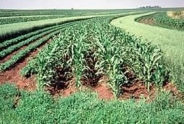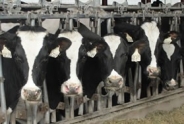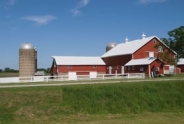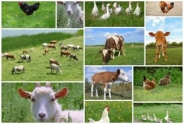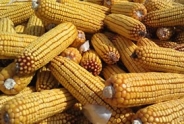Dystocia in Small Ruminants
Amy Barkley, Livestock Specialist
Southwest New York Dairy, Livestock and Field Crops Program
It's lambing and kidding time for those early season babies. In an ideal world, ewes and does are able to produce a lamb or kid within about 45-60 minutes of beginning active labor1. However, it is common for up to 5% have some sort of trouble2. Dystocia can be caused by malpresentations, which, depending on the severity, can be addressed by a flock or herd caretaker.
When approaching any dystocia, it is important to be wearing OB or breeding sleeves to help limit the introduction of bacteria and foreign material in the reproductive tract. The liberal addition of lubricant will aid in maneuvering around the space while providing comfort to the ewe or doe. Correcting and pulling malpositioned fetuses is a stressful business and while timing can be critical, care should be taken to adjust and pull the young from the dam slowly and gently.
Below are some common dystocias, their causes, and how to approach aiding the doe or ewe.
Ring Womb
This condition is encountered when the cervix does not dilate completely to allow passage of a lamb or kid. Catching it early is important, since if left alone, the ewe will continue to make no progress, resulting in the possible death of her and/or her offspring.
Ring womb presents as a water bag hanging outside the body for more than 30 minutes, with a lack of straining from the dam. Upon reaching through the vagina towards the uterus, you will be halted by the cervix, which is not dilated enough to let a whole hand, let alone a lamb or kid, pass through. Sometimes, there's barely enough room for one finger to move through the cervix.
To remedy this condition, the cervix will need to be stretched gently over the course of 30 or so minutes, which simulates a natural dilation. To start the process, bring your fingers together on one hand and touch them to your thumb. This makes a "duck bill", which then can be slid into the cervix and gently opened and rotated to dilate the tissue. Sometimes, ring womb presentation makes opening the cervix very difficult or impossible, resulting in the need to call your veterinarian to perform a C-section.
Malpresentations
Normally, a lamb or kid will present from the ewe or doe with two front legs orientated correctly (tips of hooves pointing upward), with the head in-between. Malpresentations are any orientation of the lamb that deviates from this. They can include tangled limbs of multiple babies, breech (backwards), and head back.
Tangled Limbs
Tangled limbs can happen when twins or triplets are attempting to exit the birth canal all at once. This can present as the dam attempting to make progress, but with no result. When attempting to pull in these situations, the puller is met with resistance and a firm stop. Sometimes the presentation can appear normal because two front legs are showing, but they actually belong to two different animals, with the head of a second baby turned back.
To verify that there are two or more offspring trying to come out at once, feeling inside the ewe or doe and following each leg back to where it attaches is key. If two legs are attached to two separate bodies, then they must be untangled before any pulling can be done.
To do this, feel around gently to get an idea of where in the birth canal each of the twins or triplets is and select one to move forward and one (or two) to push back. The one selected can be based on which head and body is more forward or which limbs are most easy to rightly position. From there, pull two feet forward, followed by the head so that it is resting atop the legs. Then, pull the lamb the rest of the way out.
Breech
This happens when the lamb or kid is positioned back end first. When this happens, the presentation of the lamb or kid is too large for the mother to pass on her own. Variations of the leg position can be present. The presentation leading into the birth canal may reveal nothing, just the tail, one leg, or two legs. The legs are identified as back legs rather than front legs because the tips of the hooves will be facing down. However, this may be an indication that the lamb or kid is upside down, so feeling down the leg for the hock joint, which feels like a pointy elbow, will confirm whether the legs belong to the back or front.
There are two options to correct this malposition. One is to push the lamb back in and spin it around before pulling it. The other is to pull the lamb or kid backwards. Older dams typically have more space to maneuver than a first time mother, which may play into the decision. The number of lambs or kids present in the uterus may also have an impact. Many times, it's easier to pull the baby out backwards.
Pulling backwards comes with an added challenge. The umbilical cord will snap before the head is out, causing the kid or lamb to begin breathing while inside the uterus and inhale amniotic fluid. Before pulling, ensure the proper positioning of the lamb or kid, which should have two feet belonging to one animal with the tail in-between. To keep the tail from lifting and getting caught on the pelvis of the ewe, make sure it is secured in your hand with the two hind legs. A steady, fast pull is essential here, with little room for error.
Head Back
When the head of a kid or lamb is turned back against the body, it makes the fetus too wide to exit through the birth canal. The typical presentation is two front feet and no head. To confirm that what are present are front legs and that the lamb or kid is not breech, there will be no hock joints present and the legs will bend backwards.
To correct the malposition, bring the legs outside of the ewe or doe and attach obstetrics chains or twine to them before pushing the lamb or kid back in. This will allow you to bring the legs forward easier once the head is brought around. Once the lamb or kid is pushed back into the dam, the head can be brought around. Center the head between the legs before bringing it forward and delivering normally.
Note that pushing a lamb back in is not an easy task. While there may be space to maneuver, the ewe or doe will be pushing back against you via her contractions. The fluid in the uterus creates backpressure that makes pushing more difficult. Providing steady pressure while pushing in-between contractions will help make this task easier. Don't be discouraged if the dam pushes the lamb back to the birth canal as you're trying to get the head around; you can always try again.
Fetus/Mother size Mismatch
This condition is described by offspring that are too large for a small dame or too small for a large dame. That said, the issues arise in the first scenario. Excessive nutrition to the dam late in gestation or selecting a sire with large lamb or kid characteristics may be to blame, but it can also be caused by a dam's small pelvic opening.
Applying extra lube and firm, but gentle pressure can help a big-ish lamb or kid fit through the small opening. If the fetus is normally positioned, pulling one leg forward more than the other will decrease the size of the shoulders, which can help it come through easier.
---
When approaching malposition scenarios, stay calm and do your best to visualize what you are feeling inside the ewe or doe to make a proper evaluation before correcting it and/or pulling. If you are ever unsure of a lamb or kid's presentation or how to help the birthing process, reach out to your herd or flock veterinarian. They've seen many of these cases before and will be able to best assist you.
This article is based off of the instructional video, "Lambing and Kidding Simulators" by Jacci Smith of Ohio State Extension.
To watch a simulator of lambing and kidding, visit this website: https://www.youtube.com/watch?v=qsEZB4kOg34&feature=share&fbclid=IwAR1Ey2yW808aNKVWo_d3dMQr0k1BAqF_se2VIc1TOLIcJPFqqx-8Dfo6wjI
Resources referenced in this article include:
- Greiner, S. (1999.) Lamb Time Management. Virginia Coopeative Extension. https://www.sites.ext.vt.edu/newsletter-archive/livestock/aps-99_02/aps-0024.html
- Sharma, A., Kumar, P., Singh, M., and Vasishta, N. (2014). Retrospective Analysis of Dystocia in Small Ruminants. Intas Polivet. Vol 15 (II): 287-289.
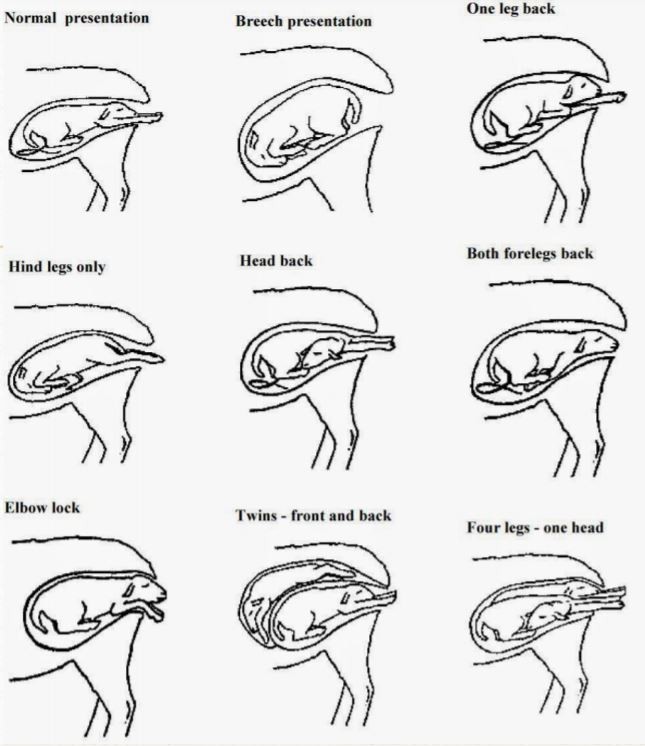
Photo from Dr. Melissa Housley's presentation, "Small Ruminant: Pregnancy and Dystocia".
Upcoming Events
WNY Pastureland Conversion & Soil Health Field Day
July 16, 2025
Middleport, NY
Join American Farmland Trust for the Western New York Soil Health Field Day on July 16, 2025, at Zeliff Farm in Middleport, NY, from 9:00 AM-3:15 PM. Learn about pasture conversion, soil health benchmarking, biochar in grazing systems, and best grazing practices. Plus, enjoy hands-on demos with the NY Soil Health Trailer, drones, and cover crops! Check out the attached agenda for more information about the field day and REGISTER HERE. Zeliff Farms is a regenerative beef operation who has recently partnered with AFT on outreach and education to farmers including learning circles and evaluating biochar effects on soil health.
IPM Strategies to Protect Corn and Soybean Seed in NY
July 30, 2025
Hamburg , NY
SWNYDLFC and Cornell IPM are hosting a grower meeting to discuss integrated pest management strategies for protecting corn and soybean seed in New York.
FAMACHA Training for Sheep and Goat producers in Woodhull NY
August 13, 2025 : FAMACHA Training in Woodhull
Woodhull, NY
Join us for a discussion and hands-on training for internal parasite integrated pest management in sheep and goats. Certification is available to all students participating in the workshop.
Announcements
No announcements at this time.

